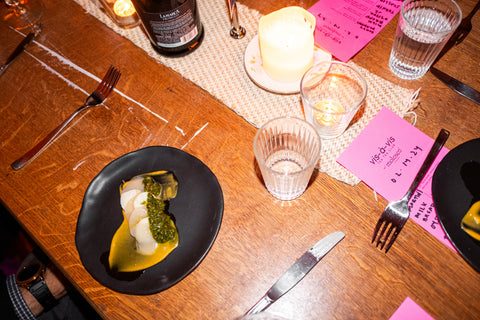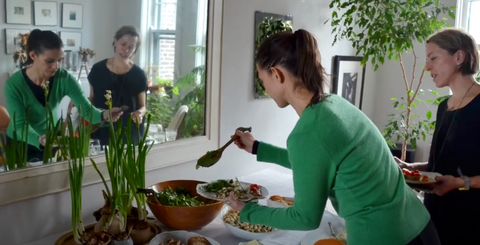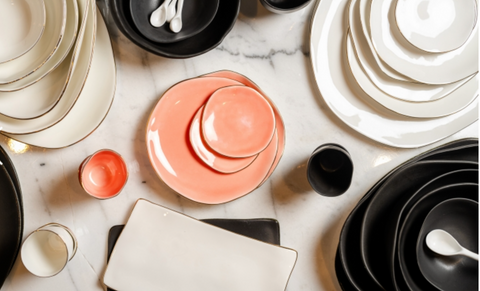So much of our practice—integral to our ethos of artmaking, of food making, of hospitality—has to do with call and response. It’s a very natural and ordinary phenomenon, to produce and create based on one’s biospheric and environmental conditions.
LIZ: Where did the name Molosco come from? I know we touched on the forms—how they resemble shellfish in the way they cup and fit together to sort of create a network for the dinner table. Was this form pursued as an inspiration from the beginning, or something that came from an organic, unknowing place?
LAURA LETINSKY: I was working in Mexico, Guadalajara, when I began to think about a title for this dinnerware. Because they nestle into one another, like oyster shells, I thought of mollusk, and because I was in Mexico, molosco.
MAX LI: A mollusc (or mollusk) is defined as a type of sea or land animal that has a soft body and is usually covered by a hard shell, for example a snail, slug, octopus, or shellfish. So I always think about the organic-ness and life of Molosco, just like the shell, to contain the soft and tender “life & body” within it, which is the food and the essence of a dinner table, and the beauty of the lived-in.
LIZ: Why porcelain? Why is it important for the brand? I enjoyed hearing you discuss the history of porcelain, the porcelain road, and how Europeans tried to imitate the material. Can you talk about this history and what it symbolizes for Molosco and other western artists working with the material today?
LAURA: Initially I wanted to work in porcelain because of its history and usage for fine dinnerware. As a collector with a limited budget, I’d gathered different porcelain pieces at thrift stores and inherited a partial set from my ex’s parent’s divorce as well as a slightly silly set from my grandmother, all with a white base and a gold line but ranging from Lennox to ornate Chinese to a more plebeian pattern. I set out to make a set of dinnerware that was white with a gold line so as to use with all of these odds and ends. Working with my hands, I fashioned bowls and plates, preferring the look and feel of these over wheel-made dinnerware.
As I worked, I read about and learned more of the tradition of porcelain, its roots in China and the long quest by Europeans to reproduce this technology, as well as its spread in Asia, in Korea and then Japan. The material is stronger in some ways than stoneware and can be made thinner, but it is also delicate, responsive to the touch, and a bit mercurial when fired, shifting in dimension and shape. I love working with it as it’s a constant balance, like dancing with a partner you know well but one still needs to attend to the other and can be surprised.
LIZ: What are both of your roles within the Molosco brand and business? You both seem to finish each other's thoughts in such a fun way. How has Molosco prospered because of this partnership? What are both of your backgrounds with food, with sharing food, both based on where you came from and where you are now in your lives? What's the most important thing to share with people when you share a meal with someone?
LAURA: The collaboration began very spontaneously as Max was in my studio and saw the dinnerware. When I told him my story of wanting to make it more available to a wider public, he was keen to work with me to figure out how we could make this happen, utilizing his connections in China—Jingdezhen, specifically—to produce the dinnerware.
We both love to cook and to share with others. I have a family with two sons, and often have friends over for dinner. Over a meal, making it as well as eating, there’s a commonality that fosters community, a giving and a taking that creates a bond. It is said that eating is the most intimate act we do (more than sex) as we take food into our bodies and it becomes who we are. To provide this for others, and to have others provide for us in this way is a kind of alchemical magic. Even the simplest of foods, a ripe tomato sprinkled with salt, a warm bowl of chicken soup on a cold day, a slice of good bread with butter… a pleasure that satiates like no other.
MAX: After Laura and I had the initial discussions, I pretty much adapted myself into the manager of the brand, which means working with designers, manufacturers, logistics companies, sales partners and all other aspects of the operations of the company. I think of Laura as the art director, who gives main artistic directions to review and approve outcomes of production (dinner pieces, packaging, gift cards, websites, and all aspects), so I keep things in accordance with Laura’s vision, as closely as possible.
I grew up in mainland China, so lots of my dining experiences were around the big round Chinese dinner table, the big round table that sometimes seats 16+ people, and the super noisy, busy, crowded holiday (and maybe funeral) dinners. People spend hours preparing ingredients, cooking, ushering everyone to the table, eating, chatting, and speaking out our feelings and thoughts to one another. It is magical, also liberating, as the kids laugh and scream to one another, parents discuss their struggles with siblings and parents, and grandparents sharing their old days, and as I traveled, I think all cultures share moments like this in different ways. So now as take my art/personal/business practice more seriously, I do consider these dinners as a good way to rebuild and recalibrate (after covid) my social practice, and Molosco is a wonderful carrier for that purpose to bring people together, to connect through the time of cooking and convening. There is a film I love by Ang Lee, Eat Drink Man Woman, which tells a story of the happenings of a family, the affairs, life goals, plans, and struggles are all woven together through each meal they share.
I think the most important thing to share with people during a meal is our time and vulnerability. Time allows us to introduce and articulate ourselves, and vulnerability allows us to open ourselves up and connect like real human beings.
LIZ: How does your photography affect your other work? I know that this practice seems to be a much different language, but how do they speak to one another? I loved our conversation about art + craft and how they are supposed to be one thing or another. Can art be functional?
LAURA: This is such a great question as it’s an issue that I’ve wrestled with since I was a kid, and it has also undergone a huge re-jiggering in the last decade or so with the acknowledgement of makers whose work did not involve oil paint and bronze, but rather, weavers, ceramicists, designers, etc.
I never understood why there was such a prohibition about art being functional. When I was younger, I would make and look at things made by others as art. Which begs the question, what is art? This question is never going to be entirely resolvable or answerable. For me, art, be it words, a plate, a flower arrangement, a painting, a photograph, etc, brings me to see and understand something about the world differently. In the encounter, I’m provoked to reconsider presumptions and definitions and to consider why and how we/I’ve come to thing “X” and to reevaluate. Sometimes this is disconcerting and uncomfortable. Sometimes it’s deeply welcome and life-confirming. So, yes, craft can be non-functional and art can be functional.
When I first began making Molosco, a collector I dearly respect warned me not to mix the two but to keep my authorship and the objects separate in the world as my dinnerware might negatively impact how I was perceived as an artist. I chose not to honor this because it’s important that (for me) life and art are not separate entities. I won’t go so far as to write that everything I do “is” art, because I don’t think it’s true, but many things I do inform and run alongside my art making including growing things, cooking, my kids, reading the newspaper, etc.
In my art, including Molosco, there is a striving for some notion of perfection that is not achievable and then reckoning with the perfection of imperfection. Allowing things to happen as much as arranging for their appearance…. The only true control or perfection is, I think, death. Life is messy, surprising, inconvenient, gorgeous, and only when I make room for life, mine and others, can art “happen,” that is, can I make art.
LIZ: Speaking of function, how do the forms of each piece speak to the user/diner/chef? Do they all serve a purpose? What was your vision for each form from a functional standpoint? Does each shape have a name? I love your phrase "alive in their imperfections." Can you talk about why this is important to the brand and how this might translate well for some but how you’ve received push back from others?
LAURA: I wanted to make dinnerware that felt good to eat from, that held the food making the experience, taste, feel, weight, all of it, a fuller experience. That the dishes are handmade gives them a feel of care, of attention, a moment out of the maelstrom that is the current digital landscape. I love grabbing street food like many, but there’s a difference eating from a plastic/cardboard/paper surface with disposable utensils that are then tossed, from that of partaking of food and drink (sustenance and pleasure) a nicely weighted visually and texturally inviting bowl and cup. Functionally, we made three different sizes of plates, bowls, and cups, as well as rectangular plates and serving dishes. Each of these are intended to be used interchangeably with and atop one another. Even along with the bits and pieces of dishes you might have from your ex’s divorced parents, the white with the gold common to so many fine China services, and the neutrality of the black, a statement of its own.
MAX: We are an artist-run company. I think about the middle space, between the mass production, such as Monobloc Chairs, and a one-of-a-kind art object. In a post-industrial, post-revolution contemporary society in which more and more mega burnouts take place, while fast food and fast fashion sustains only temporary fulfillment, the middle space then becomes more relevant (as it has always been I guess). That’s what’s driving me to keep up with pursuing Molosco, an ongoing process of developing dinnerware with relevant iterations, maintaining the quality, the organic forms, and touch of Laura Letinsky. We work with a specific manufacturer who understands that we want to produce high quality porcelain dinnerware in small to medium batches, along with updates that are in keeping with our shifting world. All businesses are relationships, and we are lucky to have our artisans in Jingdezhen who help us manage and produce these gorgeous pieces, availing them to folks who are drawn to Laura’s sturdy yet delicate aesthetics and having this unique and timeless dinnerware on their dinner table.
LIZ: How does your personal practice affect your role in Molosco? Can you talk about your production background and why it's so important for the future of the brand? And about the other dinners you have produced and why food sharing is so important to you?
MAX: I started off my artistic practice through photography, documentary photography to be exact. I traveled so much, the human interactions drove me to go out into the world, to meet, talk and greet strangers, to enter, share their spaces, and express my interest, to learn from them and exchange moments of insight about our take on life, and how experiences are relatable beyond language.
As I increasingly move into a contemporary interdisciplinary practice, I realize production is fundamental to all making; a photographer needs to print and frame their photos, a sculptor needs to have an object casted, a business person needs to get 1000 lunch boxes made. Things need to be made in order to move into the real world for other people to access and engage.
There are countless ways to make, and each is built through effort. I dabbled with production before taking on Molosco, and it was because of Molosco I became super serious about the whole production piece, not only because I like to try, not only because I am Chinese working to invest in Chinese production. I think all the decisions, changes, and mistakes that happened helped us to be better and made us think more fully about what the product means, and how to relate this to our customers in their lives. So far, I have a few production projects from traditional manufacture to 3D printing, and it is the process that matters, its journey to being an object from its design, to its making, packaging, and transportation…
Food sharing is so important to connecting with people. I think food brings us together. Molosco is a host, in invitation to welcome those who care about how they live, how they experience their world, its pleasures and necessities…



